Just a wonderful, immersive experience. As well as being a challenge, I learned so much about the local communities.
Owen K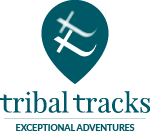
Lynsey is requested time and time again by our repeat trekkers. She is a full time mountain leader based in the North East of England.
Camp in remote, high altitude valleys, under huge skies while enjoying the warmth of the campfire.
Trek to Macchu Picchu on a trail less well trodden, experiencing more of what this amazing location has to offer without the crowds.
Explore a variety of different climates – from icy peaks to lowland jungle, as well as the beautiful wildlife.
All the info you need
Trip Details
The Salkantay Trek is what we think is the best alternative to the Inca Trail. With high snow-capped mountains to look at (not summit!), lowland jungle and a visit to the Inca site of Llactapata, the trek offers a perfect mix of trekking, culture and nature.
It is a day longer than the Lares Trail trek, but it allows you to view Macchu Picchu on your trek, allowing the excitement to build. It is also a little tougher than the Lares Trail, making the challenge, and the ultimate sense of achievement, greater.
With fewer people on the route, the Salkantay Trek allows you to enjoy the natural beauty of the Andes without any of the distractions and disturbances you may find on the Inca Trail. This will allow time for greater reflection, and the opportunity to have nights around the campfire with your team-mates, in greater isolation.
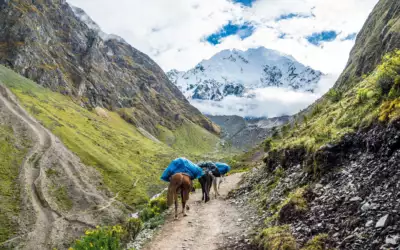
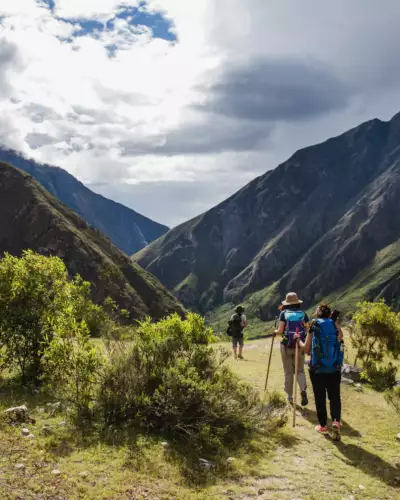
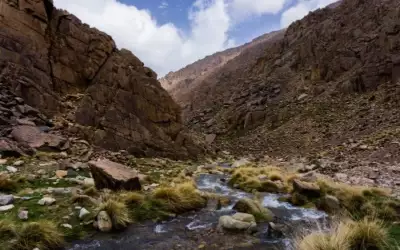
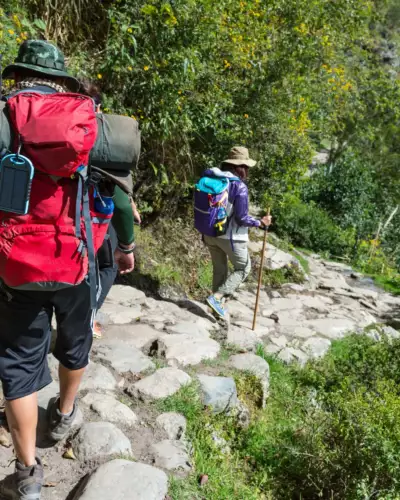
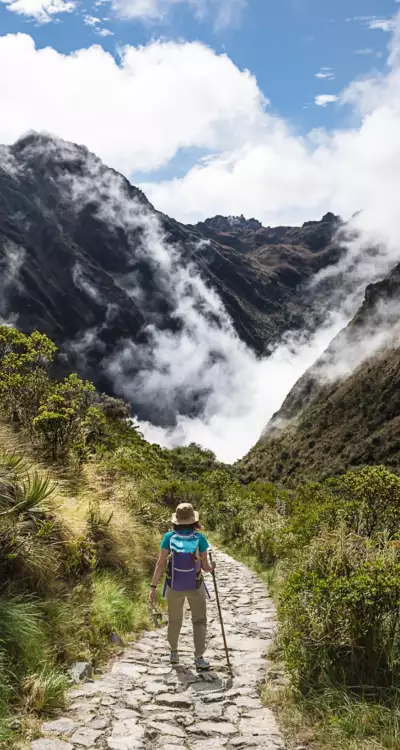
Trip Details
Depart the UK on your flight to Lima, overnight Lima airport.
This day will be under your own arrangements unless you have been quoted otherwise.
If we are arranging this leg of the journey for you, on arrival in Lima, a local guide will be waiting for you at the airport to assist you to your hotel at or near to Lima airport.
*There are no through flights to Cusco from the UK, all flights require a stop at Lima airport
Accommodation and Meals
Overnight in Lima airport hotel, twin-shared rooms.
Lima to Cusco (flight under own arrangements unless you have been quoted otherwise)
You will fly to Lima under your own arrangements unless you have been quoted otherwise. If we have ordered this section of the itinerary for you, a local guide will transfer you to the airport.
After your internal fight, upon arrival into the imperial city of Cusco (3,350m), located in the heart of the Andes Mountains, you will be welcomed by our local team who will transfer us to our comfortable three-star hotel. You are free to venture out and explore but take it easy, as the air is so much thinner than you will be used to.
In the evening, we will enjoy a welcome meal together at a charming Peruvian restaurant that provides exquisite cuisine.
Minimum altitude: 3350m
Maximum altitude: 3350m
Three-star hotel in Cusco
Meals: Dinner at Tunupa Restaurant.
Accommodation and Meals
Overnight in twin share 3*hotel, dinner.
This is the day to explore the main sites and get used to the altitude. We suggest that you take it easy, and make sure that you hydrate adequately. Altitude can cause dehydration very quickly, so drink often!!!
After breakfast in the hotel, explore under your own steam, or join your TT leader for a walk around the main sites. Cusco has many great restaurants so we have deliberately allowed you to choose where you want to eat lunch and try the local cuisine! You may want to rest in the afternoon, or continue your exploration of the sites, before joining the rest of the team for dinner at the hotel.
Accommodation and Meals
Overnight in twin share 3*hotel, breakfast, float for lunch, dinner
This is your final day acclimatising in Cusco before the trek!
We suggest that you continue your exploration of Cusco, getting used to the altitude and getting your legs moving. Again, your TT leader will co-ordinate some destinations, or you can simply explore on your own.
This evening at supper, there will be a pre-trek briefing and you should get an early night, ready for the days ahead!
Accommodation and Meals
Overnight in twin share 3* hotel, breakfast, float for lunch, dinner.
After breakfast, our trek begins!
This morning, we have a very early start to drive two hours to Mollepata (2900m). We'll stretch our legs with the increasingly thinning air and pick up any last bits we need for our trek. We continue to Challacancha (3800m), where we'll meet our support team to load our luggage onto horses and mules.
At around 0900hrs we'll trek for around three hours to Soraypampa (3900m) where our team will prepare a delicious lunch. Fuelled up, we trek a further hour and a half to Humantay Lake (4200m). This is a breathtaking turquoise glacial lake fed by the Humantay Glacier, its vibrant blue-green waters contrast beautifully with the surrounding snow-capped peaks, and is considered sacred by the Quechua people. Once enjoying this stunning feature, we return to Soraypampa to our campsite to enjoy a night under the stars.
Trekking distance: 12 km, 6 hours approx
Starting altitude: 3350m
Camp elevation: 3900m
Highest altitude: 4200m
Difficulty level: Challenging.
Meals: Breakfast in the hotel, lunch and dinner.
Accommodation and Meals
Overnight camping in twin share tents at Soraypampa, full board.
Today is the hardest day of the trek but also the most beautiful.
At 7am, we will begin the trek to Chaullay, where we will enjoy the spectacular landscapes of snow-capped peaks and rugged mountains.
From Soraypampa we start our most challenging part of the trek with an ascent to 'Pampa Salkantay', the highest point of the Salkantay Trek at 4630m. We will be rewarded with breathtaking views of Salkantay Mountain, the second highest peak in Cusco. After enjoying the views, we will descend to Huayracmachay (3912m) for lunch.
After lunch, we cross the pre-mountain and cloud forest area to arrive at the camp at Chaullay for a delicious, well-deserved meal.
Trekking distance: 22 km, 8-9 hours approx.
Starting altitude: 3900m
Camp elevation: 2920m
Highest altitude: 4630m
Difficulty level: Tough
Accommodation and Meals
Overnight camping in twin share tents at Chaullay, full board.
Our destination today is the village of La Playa, which is a welcome mostly downhill descent down the valley from Colpapampa.
Today we descend to Sahuayaco (2064m), a journey that lasts approximately 5 hours. Along this trail, you will have the opportunity to contemplate unique panoramas and the variety of flora and fauna that characterise this region. Keep your eyes peeled and fingers crossed, as this environment is home to the emblematic “Andean Cock-of-the-Rock“, Peru’s national bird. If you are lucky, you may catch a glimpse of it in its natural habitat.
After reaching Playa Sahuayaco and enjoying lunch, we will continue our Salkantay trek to tonight's camp at at Lucmabamba (2000m).
Trekking distance: 18 km, 6 hours approx
Starting altitude: 2920m
Camp elevation: 2000m
Highest altitude: 2920m
Difficulty level: Moderate.
Accommodation and Meals
Overnight camping in twin share tents- Lucmabamba, full board.
Lucmabamba descending to Aguas Calientes to celebrate
After breakfast, we will follow Peru’s famous Inca Trail, leading us to the famous postcard views of Llaqtapata (2702m). Here, we have plenty of time to explore the beautiful archaeological site that connects Sayacmarka and Machu Picchu before trekking the two-hour descent to the hydroelectric power plant. We then follow the the railway tracks to Aguas Calientes.
Aguas Calientes has a variety of restaurants where we will celebrate our accomplishment of completing the Salkantay trek.
Trekking distance: 17km, 7 hours approx
Starting altitude: 2000m
Camp elevation: 2050m
Highest altitude: 2702m
Difficulty level: Light.
Accommodation and Meals
Overnight 3* twin share hotel Aguas Calientes, full board.
Head to Machu Picchu.
After a very early start, transfer on one of the first buses to Machu Picchu to ensure we arrive at the Inca citadel before the crowds. You will have plenty of time to take pictures and enjoy the sunrise over Machu Picchu. There will be plenty of time to explore the ancient citadel and learn about the history, temples, and most significant places of Machu Picchu.
There is an option to could climb Huayna Picchu mountain. This steep mountain dominates Machu Picchu’s background, taking 1 hour to climb Huayna Picchu and 1 to 1 ½ hours (depending on if you want to visit the Great Cavern) to return down. This is an additional cost of approx £85, we would need to know if you would like this option 2 months prior to departure (not advised if you suffer from vertigo).
We return to Aguas Calientes for lunch before returning to Ollantayambo by train and an onward road transfer to Cusco.
Accommodation and Meals
Overnight 3* twin share hotel Cusco, full board.
Trip Details

Trip Details
In a nutshell, almost everything!
This is what you will need to buy/source yourself.
It is important that you read the itinerary carefully, and take account of the rating we have given it.
Although our challenges are not technical, they do require a good degree of physical fitness. The conditions will require stamina and strength, which you should recognise and train for. This will be a much better experience if you are fit and prepared. You should feel comfortable walking 6-8 hours per day.
In setting the maximum size of our groups, we take a number of factors into account.
Altitude, degree of difficulty, the terrain, the climate and time of year, all determine the maximum group size. Sometimes it will be 20, sometimes it will be 8-14, but safety is always our priority.
You will be accompanied by a Tribal Tracks UK Leader, Mountain Leader qualified, as well as supported by our local, in-country guides.
It is a requirement of Tribal Tracks booking terms and conditions that each supporter must hold their own travel insurance, which covers the trip and the activities they are doing. Read more here.
We advise you to put insurance in place as soon as possible, ideally on booking so you are covered immediately. Your insurance must be valid and in date, covering the entire period that you are travelling for, including the return journey home. It should cover medical and personal accident risks, and should include repatriation costs and air ambulance or helicopter rescue services, where appropriate.
Tribal Tracks has 100% Financial Protection and has a trust account with the Protected Trust Service, member number 5566.
This means that all client monies paid to Tribal Tracks are held in our dedicated trust account, which is supervised by an independent trustee. This means that in the very unlikely event that Tribal Tracks ceases to trade, your money is safe. For more information, please visit this link. Any flights booked for you by Tribal Tracks will be ATOL-protected under our own ATOL certificate.
Tribal Tracks considers the safety of all of its participants and staff to be a top priority, and as such we have thorough safety systems in place.
In the event of an injury, we have an evacuation plan in place for all elements of the trek route. We do ask that you look after yourself during the trek in the following way, as this will help avoid unnecessary problems:
We know that the unexpected can happen.
While you are away, things can happen at home and people may need to get in contact with you. This can be tricky when you are in remote areas. So, shortly before departure, we provide you with an Emergency Procedure document to distribute to your nearest and dearest. This sets out how to contact Tribal Tracks and the steps Tribal Tracks will then take to get in contact with you.
It is really important that you are well prepared for your physical challenge and that you are confident that you will be able to fully participate.
Although our leaders are well trained to deal with different capabilities, if they have any concerns about someone’s ability to safely partake in the trek, or their impact on other people’s enjoyment, we authorise them to take necessary action which, in some circumstances, may involve asking someone to step out of the trek. Although this is a very rare occurrence, by booking this trip you agree to section 11 of our Booking Conditions which clearly states that our leaders have the authority to do this. In these circumstances, we will ensure anyone sitting out is safely provided for and offered alternative options where possible. Refunds will not be provided for activities missed and customers may be liable for additional costs incurred.
At Tribal Tracks, Responsible Travel is enormously important to us, and our commitment to responsible travel is evidenced in every itinerary that we prepare.
Core to our business is the belief that holidays can and should be enjoyable to the traveller but should be conducted in a socially, environmentally and economically responsible manner which brings benefit to local communities. This is implemented through a variety of measures which can be found in our Responsible Travel policy. We encourage you to read this and to play your own part in travelling responsibly.
Trip Details
Trip Details
The trek is a challenge. We will be walking for a long time over sometimes challenging terrain with steep ascents and descents.
The best way to build endurance fitness is to start with some gentle walks and gradually build up both the distance and duration over the next few months. In the last 2 months, we would recommend to go out and do long days, ideally in the hills, to build up the strength in your legs. About a week before the trek, limit any training to short walks – you want to have fresh legs at the start!
For the trek you should be comfortable trekking between 6 - 8 hours per day, but remember we have all day to achieve the distances and will not be going at racing snake pace. It may sound obvious, but make sure that you are walking properly, hitting the ground with your heel first, then rolling onto your toe, which pushes you onto the next step (this will help reduce the risk of shin splints and tendon pulls). Walk with your head up, eyes forward and shoulders level.
It is a good idea to develop a level of cardiovascular fitness (exercising and strengthening your heart and lungs). This comes from running, cycling or swimming for between 20 minutes and an hour, and will really help develop your endurance fitness. Three sessions a week is normally advised, increasing time and distance over time.
Replicate conditions in training i.e., use all the kit you will be using and try your walking poles if you want to use them.
It is important to pack so that you know where everything is. Separating kit into different packing cubes, or even plastic bags can really help with this. You can pack by item (eg socks and pants in one cube, tops in another etc) or by day, putting your entire outfit for that day together in one place. Taking an extra bag or cube to separate dirty kit is a great idea.
You will have two bags on the trip - your main bag and your back pack.
You should operate on the basis that you will not have access to your main bag during the day and while you are trekking. This means that it is important to have everything you need in your back pack. Waterproofs should go in the bottom, together with an extra layer, sunscreen and sunglasses, plus hat and gloves (if you are in a colder climate). You should also have your water bottles, and any specific snacks, medicines or first aid items you want to take, such as zinc tape and blister plasters. Baby wipes/toilet roll and nappy sacks are also essential for going to the toilet while you are trekking - we will explain more in the pre-departure briefing!
In the event of an injury, we have an evacuation plan in place for all elements of the trek route. We do ask that you look after yourself during the trek in the following way, as this will help avoid unnecessary problems:
We will brief you in the pre-departure briefing as to the catering specifically for your trip. However, as a guide, each morning you will be provided with a very filling local breakfast, usually accompanied by tea or coffee. Lunch will be during your trek and will be prepared by the team of cooks or we will utilise local restaurants or teahouses. Food will always be ample and tasty. If wild camping, dinner will be in the dining tent and will be traditional, freshly prepared food. If you are staying in a hotel or teahouse, dinner will be served there. Water, tea and coffee will be served and alcohol will usually not be available, although there will be some exceptions. We will provide 4 litres of drinking water per person per day. You will need to fill up 2 litres at breakfast and another 2 litres at lunchtime.
Please ensure that you have notified us before departure if you have any specific dietary requirements or allergies as we can cater for most.
Please inform us of any dietary requirements or allergies before you travel, and preferably at the time of booking. We can cater for almost all diets, but only if we know about them beforehand.
You will sleep in shared tents (unless a single supplement has been requested). Mattresses are provided, which makes it much more comfortable! There will be a central dining tent available with rugs and lights where the group can get together in the evening, share stories and enjoy meals. There will also be an open fire wherever it is possible.
Sleeping bags are designed to work by trapping your body heat in the down surrounding you. If you wear lots of layers, your body heat will not be able to escape as effectively, and you will be cold. Wearing a thin thermal layer is ideal. It does sound counter intuitive, but we promise that it works!
Putting your clothes for the next day in the bottom of your sleeping bag will also help with warmth, as it will fill up any spare space around your feet, and it will mean your clothes are nicely warmed up in the morning.
If you find it difficult to sleep without a pillow, we recommend that you take a travel pillow and a regular pillowcase with you. Put your pillow in the pillow case, and use your down jacket/layers to fill out the pillowcase, you will end up with a pretty decent pillow!
And as for stuff or roll when it comes to packing your bag away? We are very much in the stuff camp! Read more here.
There will be early morning starts, typically around 0600 - 0700hrs, so that the team can set off on the trek in good time. It is important that you pack up your kit before breakfast and leave your bag outside your tent or accommodation so that the crew can load them onto the jeeps and/or mules. There will be a freshly cooked lunch provided on your trek route. The aim is to get into camp before sunset if possible, when you can enjoy a hot drink and snacks. It is important that you change into your thermals and put layers on when you get into camp as the temperatures can drop sharply and you need to keep warm.
In the morning, the Tribal Tracks leader will wake up the group. When you hear the call, please begin to get ready, and pack all your kit away in your 'main bag' before breakfast. Put this bag outside your tent or accommodation as the crew can then begin to break down the tents/load the luggage. Ensure that you have all that you need in your backpack for the day, as you will not have access to your main bag until the next camp (see 'What do I put in my backpack?).
When you arrive into camp, it is important to get changed into different clothes, usually the ones that you will be wearing the next day. Even if you have had dry weather, you will have been sweating, and your clothes will be damp. As the sun sets and the air cools, you will quickly feel cold. Before this, you will want to freshen up and we recommend the 'baby wipe bath'. As there are no showers while on the trek, having a freshen up with a baby wipe will help keep you clean and will make you feel much better, before you put your clean clothes on. Unpack your sleeping bag and get everything out that you need for nighttime, such as your warm hat, jacket, head torch and book. Sort out your back pack for the next day by removing rubbish and replenishing snacks etc.
Doing this before dinner will mean you can get into your sleeping bag quickly, when it is likely to feel cold.
There will be a toilet tent and water supplied for washing in the morning where we can. There are no shower facilities provided during the trek and there will be no toilets either, but there will be a toilet tent in camp in the evenings and mornings. In the pre-departure briefing, we will tell you all that you need to know about how to deal with this.
For up-to-date vaccinations information please visit the NHS website ‘Fit for Travel’ at: http://www.fitfortravel.nhs.uk. The Tribal Tracks team are travel professionals, but we are not medical experts, and we would encourage you to visit your GP or travel nurse to discuss vaccination requirements. Please remember to take your itinerary with you so that they can see where you will be travelling. You should make an appointment at least 3-4 months before you travel.
In addition, please note that information on vaccinations can change at short notice; we recommend that you contact your Medical Professional or a Travel Health Clinic at least 8 weeks prior to departure for the most up to date information.
We recommend that you bring a multi-region adapter plug with you. There will be no facility to recharge electrical items on the trek, so we recommend you bring a power bank to top up the charge. We also recommend putting your phone on Airplane mode during the day to save on power.
Using your mobile overseas can sometimes attract unwelcome, very high tariffs. We recommend that you check with your network provider before you travel, but if in doubt, keep your phone switched to Airplane mode and use it only when there is WiFi. Reception can also be patchy, and unreliable, particularly in remote areas, which is why we carry a satellite phone with us. Please let your nearest and dearest know about this, and warn them that you may not be able to be in regular contact.
We ask that your luggage is kept to the absolute minimum. We will tell you the weights that you should not exceed, but usually, your main bag should not exceed 23kgs in weight.
It is important that you wear, or take your trekking boots with you in your hand luggage on the flight, as they are vital for the trek and cannot be replaced in the event of lost luggage.
We recommend leaving behind items such as high value jewellery, watches etc. Your passport and money should be always kept on you.
Trip Details
There are many option to extend your stay in Peru, or even to explore other countries in South America. Please contact us for further details.
Have a question about Tribal Tracks? Get in touch, our small team will be delighted to help.